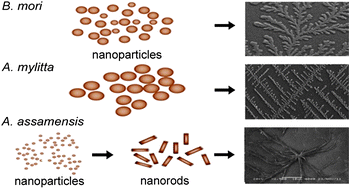Self-assembly mechanisms of silk protein nanostructures on two-dimensional surfaces†
Abstract

Maintenance work is planned from 21:00 BST on Sunday 18th August 2024 to 21:00 BST on Monday 19th August 2024, and on Thursday 29th August 2024 from 11:00 to 12:00 BST.
During this time the performance of our website may be affected - searches may run slowly, some pages may be temporarily unavailable, and you may be unable to log in or to access content. If this happens, please try refreshing your web browser or try waiting two to three minutes before trying again.
We apologise for any inconvenience this might cause and thank you for your patience.
* Corresponding authors
a
Department of Chemical and Life Science Engineering Virginia Commonwealth University, Richmond, VA 23284, USA
E-mail:
vyadavalli@vcu.edu
Fax: +1-804-827-3046
Tel: +1-804-828-0587
b
Department of Biotechnology Indian Institute of Technology, Kharagpur 721302, India
E-mail:
kundu@hijli.iitkgp.ernet.in
Fax: +91-3222-278433
Tel: +91-3222-283764

 Please wait while we load your content...
Something went wrong. Try again?
Please wait while we load your content...
Something went wrong. Try again?
N. E. Kurland, J. Kundu, S. Pal, S. C. Kundu and V. K. Yadavalli, Soft Matter, 2012, 8, 4952 DOI: 10.1039/C2SM25313E
To request permission to reproduce material from this article, please go to the Copyright Clearance Center request page.
If you are an author contributing to an RSC publication, you do not need to request permission provided correct acknowledgement is given.
If you are the author of this article, you do not need to request permission to reproduce figures and diagrams provided correct acknowledgement is given. If you want to reproduce the whole article in a third-party publication (excluding your thesis/dissertation for which permission is not required) please go to the Copyright Clearance Center request page.
Read more about how to correctly acknowledge RSC content.
 Fetching data from CrossRef.
Fetching data from CrossRef.
This may take some time to load.
Loading related content
